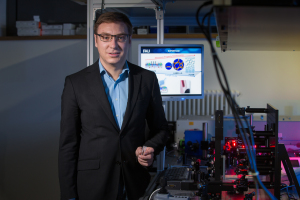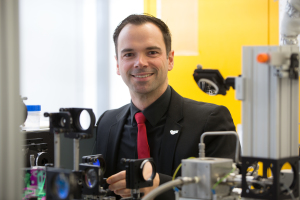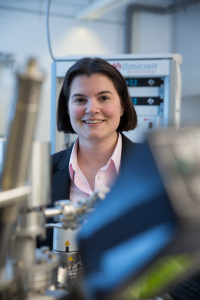Research grants worth six million euros at FAU
Four young researchers secure ERC Starting Grants amid strong competition
Four young researchers at FAU have succeeded in securing research funding in one of the toughest European selection processes. Over the next five years, the European Research Council (ERC) will provide ERC Starting Grants of 1.5 million euros each to support the outstanding research projects of Dr. Björn Braunschweig, PD Dr. Andreas Bräuer, PD Dr. Gerhard Krönke and Prof. Dr. Sabine Maier. In the strict selection process for the proposed projects, the ERC makes its decision on the basis of a comprehensive review process which involves many leading international researchers from the respective fields. Less than ten percent of the research projects submitted make the cut. Once a year, the ERC awards these grants to the best young researchers to give them the chance to establish their own working groups and pursue research projects with great potential for innovation.
What is remarkable is that three of the four grant recipients at FAU belong to two of the University’s institutes which are part of the German Excellence Initiative. Two are members of the Cluster of Excellence ‘Engineering of Advanced Materials’ (EAM) and one is from the Erlangen Graduate School in Advanced Optical Technologies (SAOT). This is a good indication that funding from the German Excellence Initiative is being invested very well at FAU. The nomination of Dr. Gerhard Krönke who works at the Department of Medicine 3 (Rheumatology and Immunology) at Universitätsklinikum Erlangen, on the other hand, once again highlights the outstanding medical research in the field of immunology that is carried out in Erlangen. A fifth researcher who also received an ERC Starting Grant this year, Dr. Edouard Berrocal from Lund University, is currently teaching and researching at FAU as a visiting professor.
Prof. Dr. Joachim Hornegger, Vice President for Research at FAU, is delighted. ‘To get four ERC Starting Grants for FAU in one go – that is an outstanding success,’ he says. ‘Our four grant recipients are truly outstanding researchers and I would like to congratulate them on this fantastic achievement. We are proud of our rising stars! This also shows how important supporting young researchers is at FAU – and how prominent we now are in the international research environment.’
Press images for download (all images: Erich Malter)
Download all images of Prof. Dr. Sabine Maier
Download all images of Dr. Gerhard Krönke
Download all images of Dr. Björn Braunschweig
Download all images of Dr. Andreas Bräuer
The foam expert: Dr. Björn Braunschweig, 35

What is the key to the perfect cappuccino? The perfect consistency of the foam on top. But how can we specifically influence the properties of foams – and not just the one on a cappuccino but foams in general? The solution to this problem would open up a whole new range of possible applications of foams, such as the purification of antibodies or raw materials. This, in turn, would considerably reduce costs in these processes. However, creating foam with tailor-made properties is not that simple. Researchers first have to gain an understanding of how a foam is formed at the molecular level and how the molecular structure at the interface – the place where the gas and liquid in the individual bubbles meet – affects a foam’s properties, such as its stability. Björn Braunschweig will look at the A to Z of these mechanisms in his ERC project. He will study all levels of the hierarchy, from the minute to the gigantic, examining the molecular structure at the interface, the foam bubbles themselves along with their walls and lamellae, and finally the foam which is visible under the microscope. An interdisciplinary approach which combines basic research in physics and chemistry with process engineering is required in order to succeed. Björn Braunschweig has already worked intensively in all three of these disciplines – and they are united in an ideal way at the Chair of Particle Technology where he carries out his research.
Björn Braunschweig uses a sophisticated method of examination called non-linear optical spectroscopy. This spectroscopic method can be used to examine the molecular structure of interfaces in a targeted way. This is done using ultra-short laser pulses whose intense electromagnetic radiation can be transformed into light with different wavelengths through interactions with substances or molecules. For example, red light can be transformed into blue light. For many materials, this transformation of light is only permitted at the interface which is what makes non-linear optical spectroscopy so advantageous. The reason for this is reminiscent of the proverbial search for a needle in a haystack. The few layers or atoms or molecules on the interface must be distinguished from the vast number of molecules with almost identical properties in the volume.
Björn Braunschweig’s vision is to use the combined knowledge from experiments and analyses from all scales in the foam formation process to control and improve the properties of a foam in a targeted way. The result of this would be a super foam which could be configured perfectly for various purposes.
Curriculum vitae
Dr. Björn Braunschweig has been the head of a group of young researchers at the Chair of Particle Technology since 2012. He has been a member of the Cluster of Excellence ‘Engineering of Advanced Materials’ (EAM) since April 2014 and a mentor at the Erlangen Graduate School in Advanced Optical Technologies (SAOT) since 2013. He was awarded the Alexander von Humboldt Foundation’s Feodor Lynen Return Fellowship at FAU in 2011. From 2009 to 2010, he carried out postdoctoral research at the University of Illinois at Urbana-Champaign (USA) as a recipient of the Feodor Lynen Research Fellowship for Postdoctoral Researchers.
He studied physics at TU Clausthal where he also completed his doctoral degree in 2009. During this time the focus of his future research was already clear: non-linear optical process and surface science. Dr. Björn Braunschweig has ten years of experience in non-linear optics combined with surface science – with a background in three different disciplines, physics (doctoral degree on charged surfaces), chemistry (postdoctoral research on electrocatalysis) and process engineering – that he will draw on for his ERC Starting Grant project.
Shaken, not stirred: PD Dr. habil. Andreas Bräuer, 36

High pressure process technology has a wide variety of every-day applications. It is used, for example, to decaffeinate coffee, to extract flavourings, oils and pharmaceutical agents from natural materials, in the combustion processes in diesel and petrol engines, and in a variety of processes used to manufacture extremely fine particles. The flexibility of high pressure process technology makes it possible to alter the steps of a process – and with them the properties of the product being manufactured – simply and exactly by changing the pressure. However, the process also has disadvantages. The diffusion is low in relation to the viscosity of substances, meaning that during mixing processes it takes some time before two substances become properly mixed at the molecular level. The consequence of this is that two substances may already start reacting with one another during the mixture formation process even if – due to the slow diffusion – they are not yet homogeneously mixed with one another at the molecular level. This reaction takes place in a system that already appears to be perfectly mixed to the naked eye but is actually still heterogeneous at the molecular level. As the reaction itself also takes place at the molecular level, the inhomogeneities of the mixture before the reaction are transferred to the properties of the finished product after the reaction, meaning that the product then usually also displays undesired inhomogeneities.
In his research project Andreas Bräuer will be examining this mixture heterogeneity in high pressure processes and how it influences product properties, more specifically during the mixing process itself in systems with technically relevant dimensions. For this reason, microscopes cannot be used for analysis. Optical measuring techniques must be used which make it possible to extract information about the state of the mixture at a specific place and time at both the molecular and macroscopic levels. Andreas Bräuer has developed such instruments himself in recent years.
Curriculum vitae
After completing his degree in chemical engineering at FAU, PD Dr. Andreas Bräuer completed his doctoral degree on the subject of technical thermodynamics at FAU’s Faculty of Engineering in 2007, at which time the topic of mixtures was already a key focus of his work. He completed his habilitation on technical thermodynamics at the Faculty of Engineering, for which he was awarded authorisation to teach at FAU in September 2014.
Since 2007, he has been head of the Applied Raman Scattering Laboratory at the Erlangen Graduate School in Advanced Optical Technologies (SAOT) which was established at FAU in November 2006 as part of the Bavarian and German governments’ Excellence Initiative. He is also a member of the SAOT Board of Directors as managing director. Over the course of his academic career, he has also held many positions in teaching and research abroad, such as at FAU Campus Busan in South Korea and as a visiting professor at the University of Salerno in Italy.
The phagocyte specialist: Dr. Gerhard Krönke, 36

Each and every day our immune systems have the difficult task of distinguishing between harmful micro-organisms and the body’s own cells. This decision process has far-reaching consequences, as an immune response against micro-organisms is required for effective, long-term immunity, while an immune response against the body’s own cells can lead to life-threatening autoimmune diseases. Preliminary work by Dr. Gerhard Krönke’s working group has shown that the human immune system carries out a kind of co-ordinated waste separation process using specialised phagocytes at an early stage in inflammatory processes. This process allows pathogenic micro-organisms and the body’s own material to be dealt with and disposed of separately. It causes the protective immune response against pathogens and, at the same time, supports the maintenance of immunological tolerance towards the body itself.
As part of the ERC-approved project, Krönke and a team of researchers aim to develop new methods of examining co-ordinated phagocytosis and the subsequent processing of pathogens and the body’s own dead cells. The knowledge gained through this research will enable a better understanding of the molecular mechanisms behind this process, which in turn will allow new treatments for infectious and autoimmune diseases to be developed.
Curriculum vitae
Dr. Gerhard Krönke, who is originally from Vienna, completed his doctoral degree at the Medical University of Vienna in 2002. He then worked as a postdoctoral researcher there at the Institute of Vascular Biology. After a two-year research stay at the University of Virginia, Charlottesville, USA, Krönke came to Universitätsklinikum Erlangen where he initially worked as a junior physician (Assistenzarzt) at the Department of Medicine 3 – Rheumatology and Immunology. He has also been head of a research group at the Nikolaus Fiebiger Centre of Molecular Medicine since 2009 and is now a senior physician (Oberarzt) at the Department of Medicine 3, a position he has held since 2012.
The molecular-scale weaver: Prof. Dr. Sabine Maier, 35

Modern electronic devices not only have to be increasingly powerful, they also have to be increasingly small. Molecular electronics makes it possible for incredibly small components or sensors to be made from functional molecules which act like a switch, conductor or memory cell. In light of this, the question of how the configuration of molecules and the way in which they interact with one another on an electrically insulated surface – an insulator – can be controlled is important in order to be able to develop new classes of material and minute electronic components with tailor-made properties in the future. Sabine Maier is using high-resolution scanning probe microscopy to do this. This is a method used in surface physics in which a sharp probe scans a surface step by step. This allows images of individual molecules and atoms on surfaces to be taken and also allows these molecules and atoms to be manipulated. Researchers can use this technique to examine not only the structure but also the electronic properties of molecular networks on different surfaces. Thanks to the ERC Starting Grant, Sabine Maier will be able to proceed with her latest research project in which she aims to use individual molecules to construct new molecular films on electrically insulated surfaces – and join them together to create new two-dimensional materials. The molecular components are vaporised in an ultra-high vacuum and spontaneously settle on the insulator, organising themselves. Sabine Maier wants to find out which reactions and which surfaces are suitable for joining molecules together very tightly through covalent bonding to create impossibly thin carpets of molecules using light or heat. The difficult art here is to weave the carpet together in such a way that it has as large a surface area and as few errors as possible. Sabine Maier will examine incredibly small pieces of these new networks with a scanning probe microscope at very low pressure (ultra-high vacuum) and temperature (-268°C), in a state where they are almost frozen still, so that the molecules do not move and their electrical properties can also be measured. This will make it possible for extremely stable, highly conductive molecular carpets to be created and measured – and for conclusions to be drawn as to which molecular structures are most suitable for nanoelectric applications.
Curriculum vitae
The Cluster of Excellence ‘Engineering of Advanced Materials’ (EAM) appointed Prof. Dr. Sabine Maier as a W1 Professor of Scanning Probe Microscopy at FAU’s Department of Physics in October 2010 as part of the EAM Rising Star programme to support young researchers. She has been a member of the Bavarian Academy of Sciences and Humanities’ Young Scholars Programme since 2012. She was awarded an EAM Starting Grant worth 100,000 euros in 2013, which enabled her to set up her own working group and carry out preliminary research for an ERC Starting Grant application. Being awarded an ERC Starting Grant of almost 1.5 million euros is a great step forward for her career. She will use part of the grant money to increase the number of people in her working group.
Born in Switzerland, Sabine Maier studied physics at the University of Basel where she completed her doctoral degree in experimental physics on the subject of atomic force microscopy in 2007. As part of her doctoral studies she spend a year working as a researcher at McGill University in Montreal (Canada). She was a postdoctoral researcher at Lawrence Berkeley National Laboratory in Berkeley (USA) from 2007 to 2010. Sabine Maier is now very well integrated into the team at the Cluster of Excellence in Erlangen, and is also involved in a Collaborative Research Centre and a Research Training Group. Her expert knowledge of scanning probe microscopy is in high demand here for many different applications.
Further information:
Press Office
Phone: +49 9131 8570218
presse@fau.de
